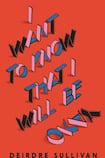
The protagonists and narrators of Deirdre Sullivan’s short stories are not okay. Most of them have little idea of how “okay” might be, except that it is a state of mind and body pertaining to other people, to the friends and relatives who find being in the world less difficult. “Her friends had all got married in the same year”, we learn of Laoise on the first page. After that, “the friends filled up their happily married wombs with little babies”. In their awkwardness and anxiety, the main characters live in the shadows of what they perceive as the ordinary, functional lives of everyone else, scrabbling to discipline their thoughts, their speech and particularly their bodies to conform to half-intuited rules. Laoise is horrified by menstruation: “She had an iPad and an Orla Kiely bag… She shouldn’t have to drip and hurt and stain.”
In Hen: “You shave your legs every second day; you hate to see the dark bumps coming… Your body’s worse than the house, you think, sometimes, for maintenance.” The heroine of Skein “get[s] to work with a four-blade razor” when “the growth of it reminded me of when the lawn got redone”. Eve struggles with make-up, with the conviction that other women are better at it while “the more she tries, the more she seems to fail”. The teenaged narrator of the title story is also trying not to try too hard: “My hair had been straightened and re-curled, and then messed a little so it didn’t look too obviously nice.” These are women from childhood to middle age caught in the toils of femininity, entirely alienated from any idea of their own desire or pleasure by the endless work of grooming.
But of course no act of repression is complete, and in every story there is a return of the repressed, the unheimlich breaking through the neatness of desperately composed homes and bodies. Hairs of strange colours manifest in places where they have no business to be, growths of various uncanny kinds sprout within those shaved, plucked, moisturised, primed, toned and conditioned bodies. There is seepage, leaking, not only from the notoriously permeable female body but within houses and between animals, ghosts and dolls. Laoise will not carry a human baby, but there are, in this story’s world, other possibilities. In Host a little girl whose parents are separating is sent to stay with her grandmother in an old house in the country, where a cold furry creature comes to sleep on her bed and eventually leads her by night to a magic well. “It takes something small from what you could be,” her grandmother says, having been visited by the same creature in her own youth, “love or health or money. Some small important thing”.
Gothic
In Little Lives a young girl’s mother goes into hospital for gynaecological surgery, leaving the child alone with damaged dolls that the mother sells online as cursed or haunted. Most houses are haunted in some way, most bodies rebel, and in both cases the inhabitants accept the limits of their own agency; the reader may be scared but the protagonist is not, because these women never believed they had any power to lose.
The stories are well-crafted and cleverly paced, creepy but not horrible. They constitute an embrace of the gothic in its traditional 18th century form, a way to explore the violence and trauma of bourgeois domestic life by imagining the explosion of all that bourgeois domesticity denies: desire and disgust; dirt; men’s vulnerability and women’s rage; blood, sweat and tears.
Read in quick succession, their concerns seem unvarying, although the settings and ages of the protagonists change. These are women who cannot find, and barely seek, companionship in their discomfort, women who want men without apparently experiencing desire or knowing what they want the men for beyond social conformity, women whose wants and fears can be expressed only through the supernatural. It’s good writing, but leaves the reader wondering if there are really so many women for whom nothing has changed in 200 years.











